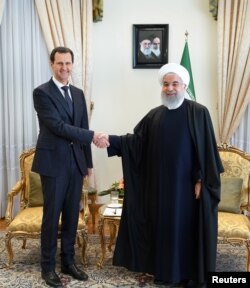Iranian military advisers in Syria are reportedly forming a new militia in the country under their supervision with the aim of boosting an Iranian agenda in the region, a rights group said in a recent report.
The Syrian Observatory for Human Rights, a war monitor that has researchers across Syria, said in a recent report that Iran has recruited at least 1,200 militiamen from different parts of Syria to form the new military force.
Iranian and Syrian officials have been considering the building of such a force for a long time, sources in Iran also said.
“This is part of a bill agreed upon between Tehran and Damascus in May 2017,” an Iranian defense reporter, who requested anonymity for security reasons, told VOA.
“The formation of any coalition with the aim of adding strength to the axis of resistance against Israel is welcomed,” the reporter said.
Axis of resistance
The axis of resistance is a term used by pro-Iranian groups that refers to an ideological-military alliance between Iran, Syria and other Shiite groups, with the goal of countering U.S. and Israeli interests in the region.
Since the outbreak of Syria’s civil war in 2011, Iran has been a major backer of the Syrian President Bashar al-Assad.
The Iranian Revolutionary Guards Corps (IRGC) has been involved in major battles across the country, providing support to Syrian regime troops against rebel forces.
Iran has also deployed Shiite militias to Syria, including the Lebanese militant group Hezbollah, and several other Pakistani and Afghan Shiite groups.
An Arabic-language, pro-Syrian opposition news website, Zaman Al Wasel, reported in late 2018 that it had obtained a Syrian defense ministry document approving a plan to give Iran more operational autonomy inside Syria.
Ali Alfoneh, a Middle East analyst who closely monitors IRGC’s activities in Syria, said he thinks the formation of this unit is highly conceivable.
“During my observations, I have identified several members of Hezbollah who were born and raised in Syria,” Alfoneh told VOA. “These signs invigorate the likelihood of this brigade.”
The Syrian Observatory report indicated the vast majority of this new militia’s fighters are Syrian nationals, functioning differently from the other Iranian-sponsored brigades that have been formed to fight in Syria in recent years.
Since January 2013, more than 2,100 members of the IRGC or affiliated militants have been killed in Syria, according to Iran’s Foundation of Martyrs and Veterans Affairs.
Tehran insists its forces are present in Syria to protect the Zainab Shrine, a Shiite holy site in Damascus, and other Shiite religious places in the country.
Western and some regional countries, however, say that the Iranian presence in Syria has been chiefly to support the Assad regime.
Indigenous Syrian militias
Seth Frantzman, executive director of the U.S.-based think tank the Middle East Center for Reporting and Analysis (MECRA), says Iran’s plans to form additional militias in Syria are part of an overall strategy to put down roots for the long term in the war-torn country.
“More bases and more militias, including indigenous Syrian militias allied to Iran further Tehran’s goal of building a corridor of influence via Iraq and Syria to Lebanon,” he told VOA.
Frantzman added, “With the U.S. announced withdrawal, Iran is seeking to hammer out a deal with Turkey and Russia regarding the future of Syria.”
On Dec. 19, 2018, U.S. President Donald Trump announced that the roughly 2,000 U.S. forces in Syria would be withdrawn.
Last month, the administration adjusted its withdrawal plans and said that several hundred U.S. troops would remain in Syria to maintain stability in the war-torn country.
The U.S. troops have been instrumental in the fight against Islamic State (IS) militants.
The Trump administration has often accused Iran of destabilizing the Middle East, particularly in countries where Iran maintains a strong presence.
“In Iraq, Lebanon and Yemen, Iran already has local allied militias. [A similar militia in Syria] would be in line with that model,” researcher Frantzman said.
During a recent meeting with Syrian Foreign Minister Walid al-Muallem in Tehran, Iranian President Hassan Rouhani praised bilateral ties between Syria and Iran.
“The establishment of complete stability and security in Syria is one of Iran’s most important regional and foreign policy objectives,” Rouhani said.









